- Home
- Stephen Baxter
The Science of Avatar Page 5
The Science of Avatar Read online
Page 5
As Alpha Centauri approaches, the ship is flipped over again and the great antimatter engine is at last fired up, burning to give a deceleration of one and a half gravities for another hundred and sixty-eight days. On return to Earth, the sequence is reversed, with the antimatter engine pushing Venture Star on its way, and the beamed-energy laser bank slowing it down at the solar system. (Incidentally many candidate designs for starships use hybrid designs like Venture Star, with more than one propulsion system; the huge distances involved push our technologies to the limit.)
How long does the journey take? Well, if you add up all the times I quoted above you’ll find the total one-way mission duration, including acceleration, cruise and deceleration, is about six years and nine months—
Wait. Jake Sully was told he’d been sleeping for five years, nine months and twenty-two days. That’s a discrepancy of a year. What’s gone wrong?
The reason these numbers are different is because of another aspect of that tremendous velocity, those vast distances, that no amount of ingenuity will let you engineer away: relativity.
9
TWINS AND TIME
The timestamp on Jake Sully’s video diary tells us that his adventure among the Na’vi begins in May of the year 2154. But if Jake’s image were beamed directly to Earth—at lightspeed, the fastest possible—it wouldn’t arrive for another four years, four months; his May 2154 journal entry couldn’t be read until September 2158.
Even our nearest neighbour the moon is a bit more than a light-second from Earth. The two-second round-trip delay was noticeable during communications between Houston and the Apollo astronauts. This made little practical difference for Apollo, but it would for RDA on Pandora. It would take a whole four years for a plea for orders from Hell’s Gate administrator Parker Selfridge to reach his superiors back on Earth, and four more years for any reply to come back. Until an effective faster-than-light communicator is invented (see Chapter 11), interstellar colonialism will be much like empires on Earth before the advent of the telegraph and radio, when messages from London, carried overland or by ship, could take weeks or months to reach British outposts in India or Australia. (In fact RDA is rather like the East India Company, used by the imperial British to subdue that subcontinent and open up its resources; the London government profited through taxes while letting private enterprise take the strain.) And, just as in imperial days, because of lightspeed delays interstellar colonial administrators will enjoy a great deal of autonomy—a situation that can go horribly wrong.
But there’s more to lightspeed and time than this kind of administrative challenge. If it’s 19 May 2154 at Alpha Centauri, what’s the date on Earth?—which is, after all, more than four light years away. Come to that, what time is it on the moon right now? If Charlie Duke, who worked as ground communicator at Houston during the landing of Apollo 11, had tried to synchronise his watch with Neil Armstrong’s on the moon, there would have been a comedy of errors as Duke’s “Mark!” reached Armstrong’s ears a whole second later, with Armstrong’s own “Mark!” coming back to Earth a second after that.
I suppose Duke and Armstrong could have agreed between themselves that Houston time is the “master,” and any records made by Armstrong and Aldrin on the moon could reflect this. Perhaps in the Avatar universe some such administrative arrangement will be made, so that on Jake’s video-record time stamps a date of 19 May 2154 as recorded on Pandora will have an unambiguous meaning, whoever’s viewing it, on Earth or Pandora. Similar reconciliations have been made in the past. In the nineteenth century the coming of the railways, and the need to draw up timetables everybody could agree on, inspired the first moves to set up national time frames. In Britain, for a long time, the official time was called “railway time.”
But that’s just bureaucracy. There’s something more fundamental here. When is it “really” 19 May—when it comes up on the calendars on Earth, or on Pandora? Is there some universal time frame we can all appeal to? Can we synchronise our local times by the ticking of some cosmic clock?
Unfortunately (or wonderfully, depending on your point of view) the universe we live in is stranger than that. Albert Einstein proved that not only is there no universal time frame, there isn’t even a universal rate at which time passes. This is all because of relativity.
Relativity is a conceptual challenge.
The trouble is, relativistic effects depend on lightspeed, which is a very high speed (three hundred thousand kilometres a second in a vacuum). So on the scales of the short distances and low speeds on which we generally live our lives, relativistic effects are unimportant, too small to be noticed (but not too small to be measured by fine enough instruments, which is how we know Einstein’s ideas are correct). Relativity isn’t part of our everyday “common sense” universe; we didn’t evolve with it, and so it’s hard for us to grasp.
But special relativity, at least, isn’t terribly hard mathematically. (“Special” relativity deals with the mechanics of motion; Einstein’s later theory of “general” relativity deals with gravity: curved spaces, black holes and wormholes.) After all the theory was dreamed up, at the beginning of the twentieth century, by a young patent clerk in Switzerland with too little to do and too much imagination, who wondered how the universe would look if you could travel with a light beam…
And Jake aboard Venture Star, barrelling through space at over half lightspeed, certainly can’t ignore relativity’s effects.
The basic principle of special relativity is to do with lightspeed itself. Suppose you’re travelling on a train coasting at a uniform hundred kilometres an hour. I choose a more modern carrier, a French TGV perhaps, and on a parallel track I overtake you at a hundred and twenty kilometres an hour. From your point of view, if you measure my motion, you’ll see me pass at the difference of our velocities—my hundred and twenty less your hundred means you see me pass at twenty kph.
This works fine at our everyday scales, but not when lightspeed is involved.
Suppose instead of riding my TGV I fire a laser beam along the track beside you. I would measure the speed of that beam at the standard three hundred thousand kilometres per second (ignoring for now the complication that lightspeed varies in different media, such as air). You, in your carriage, by analogy with the overtaking trains, ought to measure the speed of the same beam at three hundred thousand kps, less your hundred kph. Correct? Wrong—you would derive the same speed as I would for the light beam, even though we are moving at different velocities. I know this defies common sense, but, remember, we are tiptoeing into realms outside our everyday experience.
The explanation derives from physics older than Einstein’s, the theory of electromagnetism developed in the 1860s by Edinburgh physicist James Clerk Maxwell—the same man who predicted that a beam of light can exert a pressure.
Light can be regarded as an electromagnetic wave, and so all its properties, including its speed, are predicted by Maxwell’s theory. But that’s a puzzle. Einstein clung to a basic principle of physics: in a lab moving at a uniform speed, so suffering no acceleration—a lab such as you could set up on your hundred-kph train—you ought to find reality obeying the same physical laws as in any other lab moving at a uniform speed, even if the speed is different. You couldn’t feel the motion, so, said Einstein, it should make no difference to the physics.
And that’s why the speed of light is such an oddity, unlike other speeds such as the speed of a moving train, or even the speed of sound. Lightspeed is a physical constant, a fundamental part of the fabric of the universe, like the charge on the electron. You can measure it as a ratio of other physical quantities that you can determine in the lab. And if two observers measure the speed of the same light beam, even if they are moving at different speeds themselves, they have to get the same answer.
So what happens when you do try to measure lightspeed aboard a moving train? If the speed always comes out at the same answer, your measurements of distances and time must vary, depending on h
ow fast you travel. This is where the famous contraction of space and dilation of time at high speeds comes from. Specifically, as seen from back on Earth, Jake’s rulers shrink in the direction of Venture Star’s motion, and his clocks slow down; “dilation” means stretching. But Jake doesn’t notice, because his body “shrinks” in proportion, and the internal clocks of his body “slow down” too.
I know—it’s extraordinary. But if you hang on to the basic idea that distances and times adjust themselves so that lightspeed always comes out to the same number whatever your own speed, then you have the essence of special relativity.
So what does this mean for Jake on his starship?
Suppose Jake sails off on Venture Star, waved away by his twin brother Tommy. (Yes, I know, if Tommy had been alive Jake wouldn’t be going to Pandora as his replacement at all—but bear with me.)
When he’s woken, Jake is told that he’s been in cryosleep for five years, nine months and twenty-two days. But as Tommy sees it from Earth, Jake’s time slows down and his distance is compressed, and by Tommy’s clocks Jake has taken six years nine months to get to Alpha Centauri. If Jake comes straight home he will arrive back several years younger than his twin, for less time will have passed for him on both legs of the journey. An extraordinary thing: when the twins are reunited, Jake is suddenly younger than his twin. Isn’t he?
You might be troubled by something fishy here. That was Tommy’s point of view. What does Jake see? For him, Earth with Tommy aboard apparently sails off at seventy per cent lightspeed. From Jake’s point of view, isn’t it Tommy whose clocks should be slowed down? And if Jake were to return, shouldn’t it be Tommy who’s younger? This is known as relativity’s “twin paradox”—and the name is why I was so keen to bring Tommy back from the dead, briefly.
The resolution is that the twins’ situation isn’t symmetrical, because of those acceleration phases. Jake undergoes accelerations that Tommy doesn’t; Jake feels the boost phases (or would if he was awake), which Tommy doesn’t. When he got back to Earth Jake would find he was the younger twin—and Tommy would agree.
Because of calculations like this, Einstein, dreaming in his patent office, realised there could be no universal clock, no universal time. Every clock in the universe is in motion, and most of those motions will be different: Venture Star’s chronometers sailing the gulf between the stars, Tommy’s clock on Earth sailing around the sun, Quaritch’s clock in his Dragon gunship as he flies over Pandora, as it orbits its parent world Polyphemus, as it orbits Alpha Centauri A. Each of those clocks is measuring only its own “local” time, which runs at a different rate from the time measured by any other clock, a time with meaning only for those travelling with that clock. In Einstein’s universe there is no grand frame, no tremendous cosmic graph with universally agreed axes. All that exists are events: points in space and time. But there is good mathematics that lets us handle all of this. And relativity helps us understand causality. Because the scattered events can only be connected by effects that travel at lightspeed or less, lightspeed is what makes sure cause and effect occur in the right order.
Whether you think this kind of universe is entrancing or appalling depends on your point of view. But, according to our very best measurements, this is the universe we’re stuck with, and we’ll have to face relativistic consequences if we ever build a working starship.
But that is a big if.
10
THE ULTIMATE ROCKET
Humans have already sent off four interstellar craft, of a sort: the unmanned Pioneer and Voyager probes of the 1970s. Having been launched by chemical-propulsion rocket boosters, they escaped from the solar system after slingshotting off the gravity wells of the giant planets. None of them is heading for Alpha Centauri, but Voyager 2 will pass within a light year of the nine-light-year-distant star Sirius—after a cruise, not of five or six years, but nearly four hundred thousand years.
Our modern chemical-engine rocket technology is clearly far too feeble to challenge the huge distances to the stars. How can we do better?
We’ve already looked at lightsails, interstellar sailing ships pushed by light itself. But what about rockets? All our spacecraft so far have been powered by rockets. Can we get to the stars that way?
Isaac Newton understood that to make any rocket work, you have to throw something out the back, the faster the better, and that applies whether you’re talking about a Chinese firecracker or Venture Star. (This is Newton’s Third Law of Motion.) The velocity increase you get per kilogram of fuel depends on the velocity of your exhaust products. The space shuttle’s oxygen-hydrogen fuel, which is the best possible chemical system, has an exhaust velocity of a weedy few kilometres a second.
We could do better with a starship we could probably build tomorrow, if we really had to. Perhaps mankind’s earliest practical dream of a starship came out of our worst nightmare: a ship driven by nuclear bombs, a whole stream of them, thrown behind a huge spring-loaded pusher plate and detonated. Project Orion was run from 1957 to 1965 by General Atomic, a division of a company that also built nuclear submarines and intercontinental ballistic missiles. It was a time of extravagant dreams inspired by the new technology of thermonuclear detonations, the energies of the sun brought down to Earth. Orion was like putting a firecracker under a tin can to fire it into the air: not pretty, but effective. One analysis predicted that it would be possible to have sent humans as far as Saturn by 1970. However, growing opposition to nuclear weapons through the 1960s caused the Orion concept to be viewed with suspicion. The final straw was an unwise presentation to President Kennedy of a model of a spaceborne Orion-technology battleship, bristling with nuclear missiles. Kennedy was disgusted, and the project was canned.
A more refined version of the Orion idea is a technology called nuclear pulse propulsion. This was used in a conceptual study called Project Daedalus by the British Interplanetary Society in the 1970s. The ship would be driven forward by a series of micro-explosions, pellets of deuterium and helium-3 blasted by lasers and blowing up behind a pusher plate. This kind of drive could throw out its exhaust at something like a thousand kilometres a second, maybe hundreds of times better than chemical technology.
The ultimate rocket exhaust speed, however, is the speed of light—the universe’s speed limit, around a hundred thousand times the shuttle’s exhaust velocity. With such an exhaust velocity you’d have the best rocket you can possibly build.
And this is what must have drawn the attention of RDA’s rocket engineers to antimatter.
Antimatter’s existence was predicted theoretically as long ago as 1928, by a young physicist called Paul Dirac. Dirac was seeking a way to unite Einstein’s special relativity with another theory: quantum mechanics, the theory of matter, energy and motion on very small scales—brand new in 1928, still brain-bending today, and happily we don’t need to look at it too closely in this book. Dirac found that his resulting theory contained a prediction that for every type of subatomic particle there must exist an anti-particle: that is, a particle with the “quantum numbers” that define it all having opposite signs. Thus to the negatively charged electron there is an “anti-electron,” also called a positron, with positive electric charge, and other less familiar properties similarly mirror-image reversed.
Rocket engineers, and other fans of big explosions, soon realised that this “antimatter” had the beguiling property that if a chunk of it came into contact with an equal-sized chunk of normal matter, both chunks would be annihilated completely, in a flash of radiation. This made it stupendously efficient as an energy source, with all the propellant mass turned to energy; even the nuclear fusion processes that power the sun and thermonuclear bombs only turn a few per cent of the fuel mass to energy. A single gram of antimatter could deliver more energy than is contained in a thousand space shuttle external tanks full of fuel.
And because the result of the annihilation is pure radiation, you could stick the stuff in a rocket and immediately get that ideal
lightspeed exhaust.
The first conceptual antimatter rocket design was by a German engineer called Eugene Sanger (who, in the 1930s, had sketched a rocket bomber-plane that could have struck New York; happily it was never built). In the 1950s Sanger produced a rocket design based on the annihilation of positrons with electrons; the gamma-radiation “exhaust” would fly out at lightspeed. The problem, however, was directing that exhaust. The gamma-ray photons fly out of annihilation events in all directions. If they were charged particles you could use a magnetic field to point them in the right direction—namely, out the back of the rocket. But as photons have no electrical charge there was no way of controlling them.
In the 1980s Robert L. Forward, of lightsail fame, came up with a workable design based on protons, massive fundamental particles. These annihilate with their antimatter twins, antiprotons, in two stages. First they produce particles called pions, some of which are charged. The pions soon decay to gamma rays—but not before you can use a magnetic field to hurl these charged particles out the back of your rocket as your exhaust. So this is a “pion” rocket rather than a true “photon” rocket, but it’s the closest anybody has come so far to the ideal.
Venture Star’s engine is an advancement on these lines, depending on a hybrid system, using a deuterium fusion process along with the antimatter annihilation.
When dealing with antimatter there are always practical problems of containment. You have to keep your antimatter from any contact with matter, even the walls of any fuel tank, if you want to live through the trip. The only way we know to do this is with magnetic fields, perhaps with the antimatter in the form of plasma, a charged gas. The most famous fictional use of antimatter as a fuel has probably been in Star Trek, in which it provides the energy for the faster-than-light warp field. The antimatter is contained in “pods”; starships are regularly wrecked when the containment fails. In the modern world the “Penning traps” used for such purposes, to contain the tiny amounts of antimatter produced in particle accelerators, are minuscule by comparison to what you’d need for Venture Star. And they’re short-lived. The longest anybody has trapped a handful of antihydrogen atoms so far is a mere thousand seconds, about sixteen minutes.

 The Martian in the Wood
The Martian in the Wood THE H-BOMB GIRL
THE H-BOMB GIRL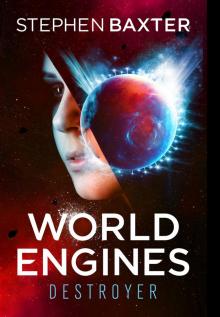 World Engine
World Engine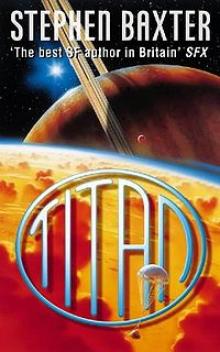 Titan n-2
Titan n-2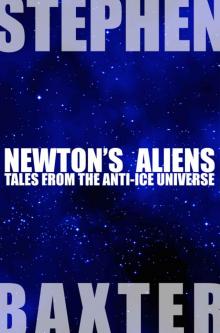 Newton's Aliens: Tales From the Anti-Ice Universe
Newton's Aliens: Tales From the Anti-Ice Universe Exultant
Exultant Manifold: Origin
Manifold: Origin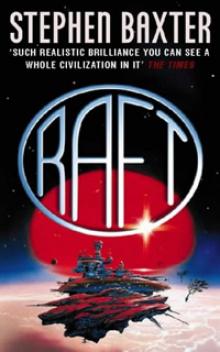 Raft xs-1
Raft xs-1 Bronze Summer n-2
Bronze Summer n-2 Transcendent
Transcendent Stone Spring
Stone Spring Coalescent
Coalescent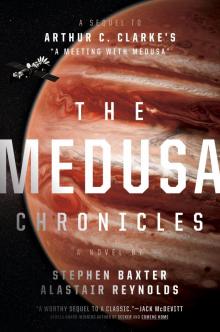 The Medusa Chronicles
The Medusa Chronicles Origin m-3
Origin m-3 Silverhair tm-1
Silverhair tm-1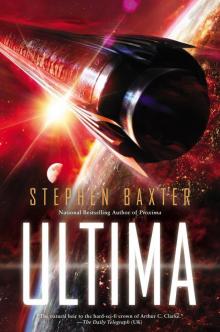 Ultima
Ultima Voyage n-1
Voyage n-1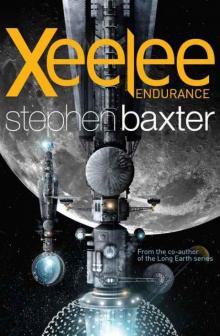 Xeelee: Endurance
Xeelee: Endurance Space m-2
Space m-2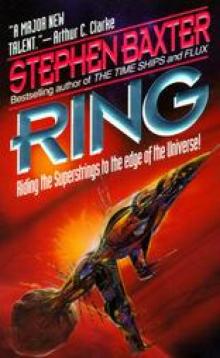 Ring xs-4
Ring xs-4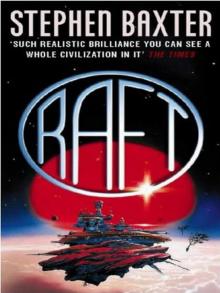 Raft
Raft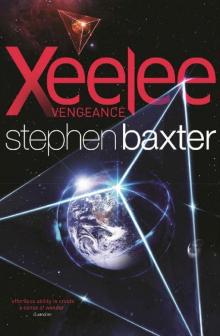 Xeelee: Vengeance
Xeelee: Vengeance Iron Winter n-3
Iron Winter n-3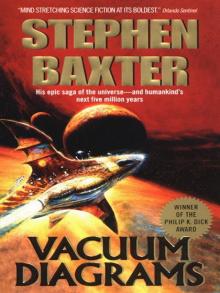 Vacuum Diagrams
Vacuum Diagrams Longtusk tm-2
Longtusk tm-2 Proxima
Proxima Evolution
Evolution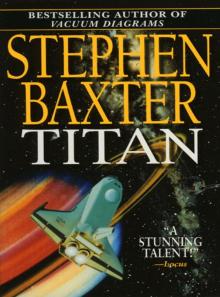 Titan
Titan Last and First Contacts (Imaginings)
Last and First Contacts (Imaginings) Emperor
Emperor The Massacre of Mankind
The Massacre of Mankind Starfall
Starfall Doctor Who - The Wheel of Ice
Doctor Who - The Wheel of Ice Longtusk
Longtusk Silverhair
Silverhair Conqueror tt-2
Conqueror tt-2 Flood
Flood Flood f-1
Flood f-1 Emperor tt-1
Emperor tt-1 Moonseed
Moonseed Conqueror
Conqueror Timelike Infinity xs-2
Timelike Infinity xs-2 The Ghost Pit
The Ghost Pit Xeelee: An Omnibus: Raft, Timelike Infinity, Flux, Ring
Xeelee: An Omnibus: Raft, Timelike Infinity, Flux, Ring Weaver tt-4
Weaver tt-4 Landfall: Tales From the Flood/Ark Universe
Landfall: Tales From the Flood/Ark Universe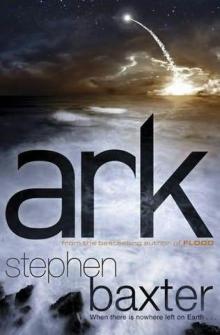 Ark
Ark Emperor: Time’s Tapestry Book One
Emperor: Time’s Tapestry Book One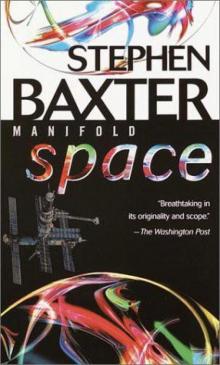 Space
Space Icebones
Icebones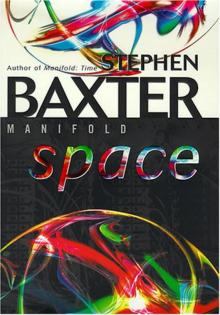 Manifold: Space
Manifold: Space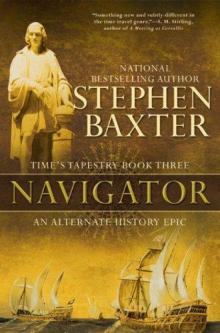 Navigator
Navigator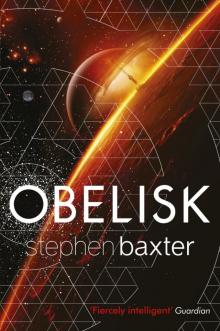 Obelisk
Obelisk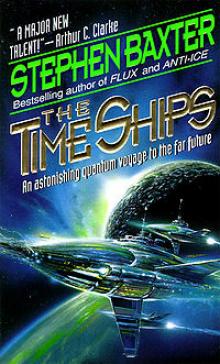 The Time Ships
The Time Ships Bronze Summer
Bronze Summer Resplendent
Resplendent Moonseed n-3
Moonseed n-3 Flux xs-3
Flux xs-3 Transcendent dc-3
Transcendent dc-3 Icebones tm-3
Icebones tm-3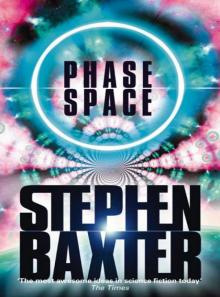 Phase Space
Phase Space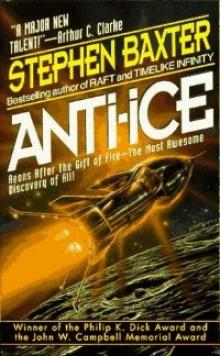 Anti-Ice
Anti-Ice Weaver
Weaver Voyage
Voyage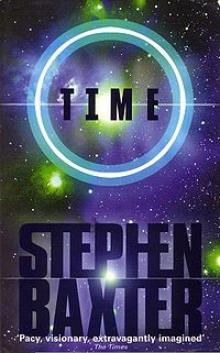 Time m-1
Time m-1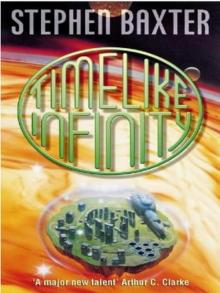 Timelike Infinity
Timelike Infinity Exultant dc-2
Exultant dc-2 Coalescent dc-1
Coalescent dc-1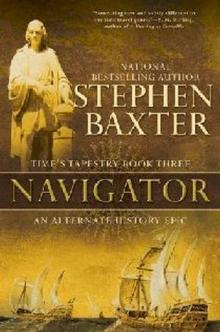 Navigator tt-3
Navigator tt-3